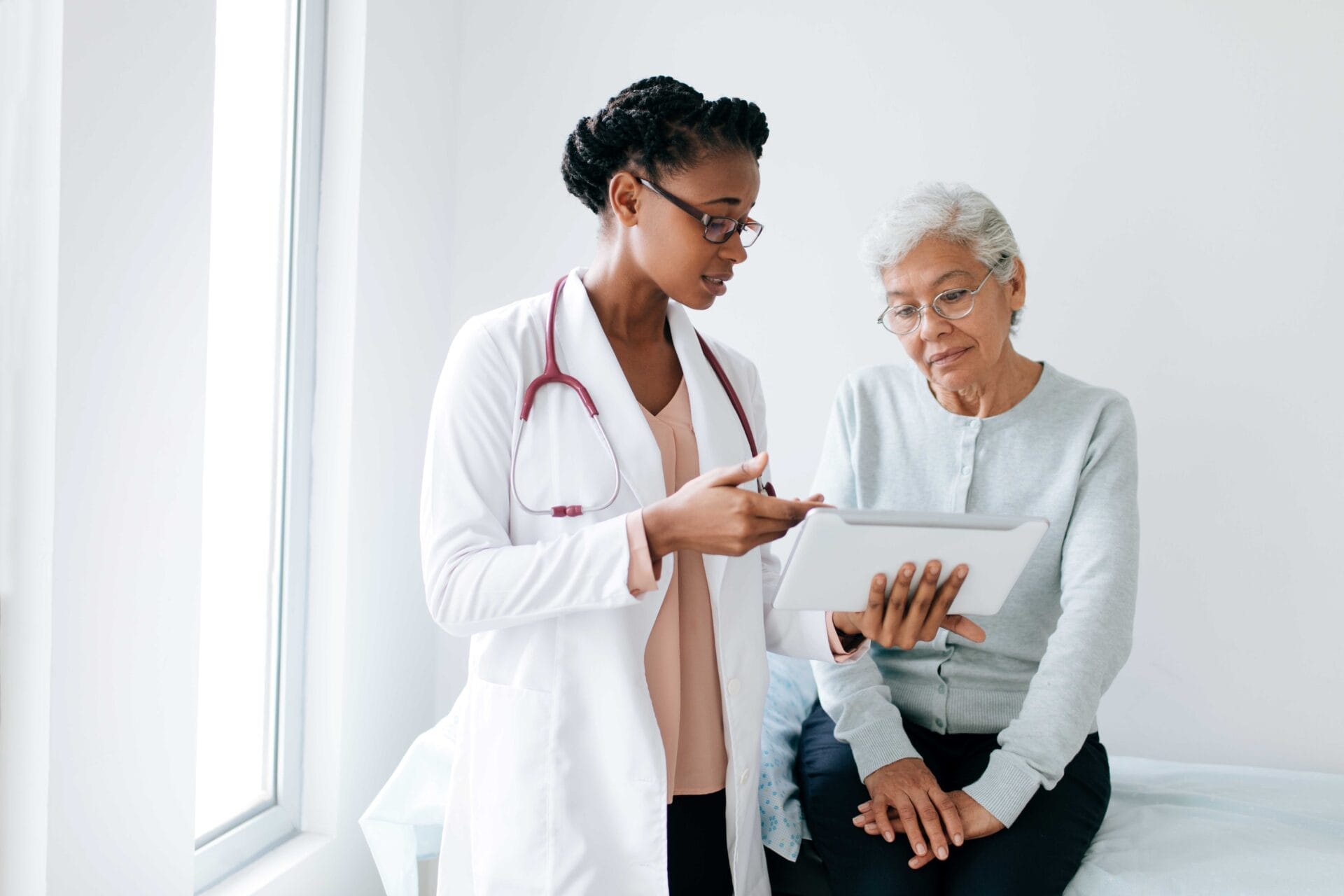Five critical factors for the commercialisation of women’s health technology
With high growth forecast for women’s health technology, it’s an attractive area for innovation. But joining the dots between concept development and commercial returns is not easy. Erica Kantor, Head of Women’s Health at Sagentia Innovation, joined Robin Stephens, CEO and Co-Founder of medical device regulatory consultancy Psephos Biomedica, in a webinar exploring the commercialisation of women’s health technology. They say medical device companies should take a holistic approach with user insights, product development, and regulatory strategy carefully aligned.
Women’s health technology innovation is beginning to move beyond its traditional realm of ‘women only’ conditions. Health issues linked to female fertility, pregnancy, menstruation, and menopause still hold innovation potential of course. But the landscape is expanding as it becomes increasingly clear that unmet women-specific needs exist in other areas too.
The fact that some conditions affect women disproportionately (e.g., depression, arthritis, and asthma) or differently (e.g., stroke and atrial fibrillation) is commanding attention. We anticipate a surge of innovation in technologies for the observation, diagnosis, management, and treatment of these conditions in women. Yet the gender data gap that has hindered women’s healthcare for so long may also be a barrier to the commercialisation of new devices. It’s important to understand this and work proactively to address it, from the outset of product design.
We’ve identified five critical factors for women’s health technology commercialisation that apply to start-ups and the innovation teams of established medical industry players alike.
How to get ahead with the commercialisation of women’s health technology
1. Understand the unique challenges of the women’s health technology landscape
Venture capital (VC) investment in women’s health technologies has made some progress in recent years. In the context of challenging wider market conditions, average deal size reached a new high of USD $10.4million in 2023. While this is a welcome gain, VC investment in women’s health technology is a fragment of that for the overall healthcare market. Part of the problem is the lack of historic commercial data. It’s hard to create reliable predictive models for return on investment in an emerging market segment.
Data gaps also affect products’ ability to satisfy regulatory requirements, and the ability of regulatory authorities to ascertain risk. Registration tends to be quicker, cheaper, and more straightforward for products with a similar use case and mode of action to others already on the market. Innovative products with no predicate and/or insufficient data on target users can face a longer regulatory review process, putting them at a commercial disadvantage.

These data challenges will take time to resolve, but governmental initiatives for women’s health provide a welcome boost in the meantime. The Women’s Health Strategy for England has set out priorities for conditions including menstrual health and menopause, the World Economic Forum launched a Global Alliance for Women’s Health, and the US White House Initiative on Women’s Health includes USD $100million in federal funding.
2. Consider a stepwise approach to commercialisation
A sound value proposition is the cornerstone of successful commercialisation in all capacities of women’s health technology product. Encompassing market and technology factors as well as user insights, it helps crystalise the ‘what’, ‘why’, ‘how’, and ‘who for’ of product development. These factors underpin the product roadmap, but the actual journey can be iterative to balance risk. In other words, a simple product with basic functionality and limited health claims will likely achieve regulatory clearance more easily and get to market more quickly.
Traditionally, product developers might achieve this by starting out with a Minimum Viable Product (MVP) that satisfies basic usability requirements. However, the development of women’s health technologies can be well-served by the principles of Minimum Lovable Product (MLP) development.
Rather than simply focusing on usability for early iterations of a product, an MLP ensures the overall experience is convenient, comfortable and enjoyable. User feedback on the MLP can inform subsequent iterations, and data surrounding its use by or for women may support future regulatory applications. This approach can also facilitate a more seamless transition from early adoption to the mainstream market, resulting in quicker commercial returns. (Find out more about MLP in our whitepaper: Minimum Lovable Product – Using empathy to make your product fly here).
3. Align regulatory strategy with product development from the outset
A lack of regulatory insight at the start of product development can stall progress later in the go to market journey. It’s important to understand which regulatory path a product is likely to take, as this impacts regulatory authorities’ data requirements. This in turn may shape key decisions during design and development.
Often, the first step is to determine whether a product will be classified as a medical device or a consumer device. This is not always as straightforward as it sounds. A product’s intended purpose, audience, and claims all impact its classification and the regulatory path it will follow. If in doubt, seek advice on this matter at the earliest opportunity. For products targeting the UK market, the Medicines and Healthcare Products Regulatory Agency has published flowcharts to help determine device type and medical purpose (available here).
It’s also a good idea to align regulatory strategy with commercial goals. As described above, a simple iteration of the product which gains regulatory clearance relatively quickly can pave the way for a longer-term pipeline. These later products build on the value proposition making stronger, substantive claims and/or satisfying user needs more effectively.
In some cases, it may be beneficial to target the consumer market initially, transitioning to a medical launch later. This was the approach taken by Bloomlife. Its wearable sensor detects contractions in the third trimester of pregnancy, with statistics displayed via an app. Initially launched as a consumer pregnancy tracker, the company later received FDA clearance for a prescription-based device. Pivoting to a medical product classification enabled Bloomlife to centre its messaging on high-risk pregnancies.
4. Apply an empathy-led approach across the entire product experience
Unmet needs that trigger women’s health technology innovation are just one part of the value proposition equation. Delivering true value – and commercial success – demands deeper understanding of how users will access and engage with the product. This is where empathetic insights come to the fore. Addressing wider pain points as well as the target health issue can enhance commercialisation, stimulating uptake via ‘market pull’ rather than ‘technology push’. For instance, understanding factors that may inhibit or facilitate women’s likelihood to seek help for a given health issue can shape strategic decisions, such as whether to aim for consumer or medical device classification.

The INNOVO non-invasive urinary incontinence treatment from Atlantic Therapeutics (now acquired by Caldera Medical) illustrates this point. In 2018 INNOVO obtained FDA clearance as a prescription only device under the De Novo pathway since there was no predicate on the market. However, Atlantic Therapeutics quickly moved to obtain over the counter (OTC) FDA approval via a 510(k) in 2020. Figures suggest that only one in five women seek help for incontinence from their doctor, largely due to stigma. So, it’s likely that this shift to a direct-to-consumer model was a strategic move to improve product accessibility and adoption.
5. Monitor women’s health technology success stories
Ongoing commercial activity in women’s health technology is a valuable indicator of market condition. It can also act as a useful barometer of future market performance.
Right now, acquisitions of women’s health technology start-ups are cause for optimism. Activity of note includes the abovementioned acquisition of Atlantic Therapeutics by Caldera Medical, an established player in surgical products for conditions including pelvic organ prolapse, polyps, and fibroids. And Maven, the first women’s health start-up in the US to become a unicorn (valued at more than USD $1billion), acquired London-based Naytal which provides virtual clinics for women.
There have also been some significant fundraising success stories. In June 2024, Amber Therapeutics secured USD $100million for its adaptive neuromodulation therapy to treat mixed urinary incontinence in women. This is the largest ever round of Series A funding awarded to women’s health. Then in July 2024 Cook Medical announced the intent to sell its reproductive health portfolio to Astorg. This indicates that private equity investors are beginning to express interest in the women’s health technology space.
Start-ups are not the only businesses making strides with new women’s health technologies. Roche received CE mark approval for its Elecsys Anti-Müllerian Hormone Plus immunoassay blood test in January 2024. This can be used as an alternative to transvaginal ultrasound for the diagnosis of polycystic ovarian syndrome. Another new diagnostic blood test, from Thermo Fisher, predicts the risk of pre-eclampsia. This gained FDA approval in May 2023.
These developments are largely centred on conditions experienced only by women. Nevertheless, they demonstrate progress in women’s health technology that will likely generate further momentum. We believe the market for solutions targeting conditions that affect women differently or disproportionately is also ripe for success. Companies that harness and leverage deep user, market, and regulatory insights throughout the product development journey will expedite commercialisation. They will also play a part in resetting the gender imbalance, improving health experiences and outcomes for women around the world.
Here at Sagentia Innovation we’re talking to, and working with, clients exploring how they can better understand the challenges in the women’s health sector and develop innovative solutions to address them. From researching the landscape for new trends or start-up partners, to developing women’s health solutions, designed with the user in mind, we’re excited about what the future holds for this space and proud to be driving the conversation. Find out more about our women’s health experience or contact us to discuss your needs. For support with your regulatory strategy and compliance requirements contact Psephos Biomedica.